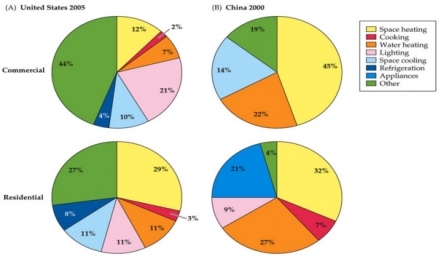Emissions from Buildings
Emissions from Buildings
| Topics: |
Buildings, if one includes the greenhouse gases produced from off-site generation of electricity and heat, are the source of nearly one-quarter of the worldwide total from human activities. [1] Heating and cooling, water heating, and lighting consume most of the energy in commercial and residential buildings.
Space Heating and Cooling
Key to energy conservation in buildings is minimizing unwanted exchanges of thermal energy between the interior and the environment, either by conduction, by convection , or by radiation. The extent of these energy transfers depends on air and moisture leaks, insulation levels, thermal properties of windows and doors, and HVAC (heating, ventilating, and air conditioning) equipment.
Thermal Leakage
The outer shell of a building serves as a barrier to impede thermal exchange between the building and its surroundings. Air leaks driven by winds, by pressure differentials from mechanical ventilation systems, and by temperature differentials continually challenge this thermal barrier. Moisture leaks degrade the performance of insulation as well as influence humidity in a building and affect comfort levels. Infrared images, which visualize temperature gradients, are helpful in pinpointing thermal leaks from buildings.
Insulation
Adequate levels of insulation not only conserve energy, but also permit buildings to downsize their heating and cooling equipment. Building insulation comes in many forms. The primary requirements of an insulating material are that it has low thermal conductance and fills space to minimize convective transfers via air movements. Some insulation is covered with shiny foil to decrease radiative transfers, and others contain moisture barriers to minimize leaks. Certain types of insulation (e.g., polyurethane) have desirable thermal properties, yet their manufacture may require an inordinate amount of energy for materials and processing. Installing insulation during the initial construction of a building is less expensive than retrofitting an existing building. In some cases, a building has access spaces that will accommodate additional insulation, or an insulating layer may be applied internally or externally. In other cases, foam may be injected into air cavities. Unfortunately, many of these foams release greenhouse gases such as CO2 and halocarbons (CFCs or HCFCs).
Windows and Doors
Buildings usually exchange a disproportionate amount of thermal energy, 10% to 40%, through windows and doors (International Energy Agency 2006a).
Window upgrades include:
1. Replacing solid aluminum window frames with either aluminum frames having thermal barriers or frames made of wood, vinyl, wood-plastic composites, or fiberglass;
2. Increasing the number of panes of glass (e.g., replacing single-pane glass with double-pane glass);
3. Increasing the air space between panes of glass;
4. Using glass that has reflective coatings or films between the panes that block the entry of ultraviolet light and the exit of infrared light; or
5. Filling the space between panes with argon or krypton, gases that have less thermal conductivity than air.
HVAC
Heating, ventilation, and air conditioning, once a rarity in developing countries, is now widespread and will more than double the building energy usage in these countries during the next few decades. [2]
• The average furnace for residential heating in the United States has increased in efficiency (thermal energy divided by chemical energy in fuel) from 73% in 1975 to 85% in 2006 (HVACWebsite.com 2008).
• Mechanical ventilation systems that exploit premium electric motors and electronic adjustable speed drives reduce building energy requirements by 10% to 15% (International Energy Agency 2006a).
• New buildings are again taking advantage of natural ventilation through courtyards, atria, wind towers, solar chimneys, and windows that actually open; for example, appropriate ventilation of houses in California could cut their energy use by 16% to 53%. [3]
• Air conditioners in the United States have improved in efficiency (cooling power divided by fan and compressor power) from 1.8 to 2.8 over the past 30 years (HVACWebsite.com 2008).
• Heat pumps expend electrical energy to transfer thermal energy between a building and its surroundings and thus can heat or cool a building. Soil temperatures below about 10 m in depth approach the average temperature of a location.
• If the annual average temperature of a location is 20°C, then thermal exchange with deeper soils can heat a building in winter and cool it in winter. This reversibility makes heat pumps less efficient than dedicated air conditioners or heaters, however. • “Thermostat wars” rage daily in houses and office buildings all over the world. Peace in our time may be achievable through flexible control systems that monitor and independently adjust temperatures in multiple locations. Manufacturers of such control systems claim energy savings of 35% to 40%.
[1] Levine, M., D. Ürge-Vorsatz, K. Blok, L. Geng, D. Harvey, S. Lang, G. Levermore, A. Mongameli Mehlwana, S. Mirasgedis, A. Novikova, J. Rilling, and H. Yoshino (2007) Residential and commercial buildings. In: Climate Change 2007: Mitigation. Contribution of Working Group III to the Fourth Assessment Report of the Intergovernmental Panel on Climate Change, Metz, B., O. R. Davidson, P. R. Bosch, R. Dave, and L. A. Meyer, eds. Cambridge U. Press, Cambridge. pp. 387-446, http://www.ipcc.ch/pdf/assessment-report/ar4/wg3/ar4-wg3-chapter6.pdf.
[2] -do-
[3] Loisos, G. and D. Springer (2000) Alternatives to Compressor Cooling, California Energy Commission, Sacramento, CA, http://www.energy.ca.gov/reports/2002-01-10_600-00-003.PDF.
This is an excerpt from the book Global Climate Change: Convergence of Disciplines by Dr. Arnold J. Bloom and taken from UCVerse of the University of California.
©2010 Sinauer Associates and UC Regents


0 Comments